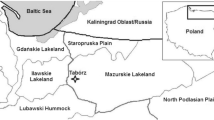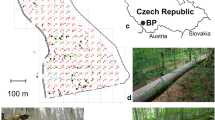Abstract
In the more than twenty years in which long-term canopy research has been conducted, mycology has been largely disregarded. Our studies using a construction crane to gain access to the canopy of a forest in Leipzig, Germany are the first long term investigations assessing the diversity and ecology of wood-decaying fungi in a canopy. Thirty-seven individuals of nine different tree species with a large amount of dead wood were selected. Sampling focussed on the four most prominent tree species Acer pseudoplatanus, Fraxinus excelsior, Quercus robur and Tilia cordata. In the years 2002 and 2003 dead wood was collected in different canopy strata. Dead branches were removed and stored for two weeks in open boxes with high humidity to allow growth of fructifications in the laboratory. 118 different taxa were identified (108 species, 77 genera). Corticioid fungi (e.g., of Corticiaceae, Stereaceae, Hymenochaetaceae) dominated the fungal composition with 37 species, pyrenomycetes were present with 18 species. Agaric fungi (Agaricales and Cortinariales) were scarce. Species with minute basidiomes dominated the fungal composition of this systematic group. Agarics with larger sporomes were found only once and were restricted to strongly decayed branches in shaded canopy areas. Concerning species richness and fungal composition the four tree species mentioned above differed remarkably. As expected, many fungi that grew on bark or slightly decayed wood showed a distinct host and substratum specifity. It is noteworthy that fungi which are purportedly to be non-specific were found on single tree species only.
Similar content being viewed by others
References
Anhuf D, Rollenbeck R (2001) Canopy structure of the Rio Surumoni rain forest (Venezuela) and its influence on microclimate. — Ecotropica 7: 21–32.
Baral HO, Baral O, Marson G (2003) In Vivo Veritas. 2nd edition. 2 CDs. Tübingen
Bellot J, Cvila A, Rodrigo A (1999) Throughfall and Stemflow. — Ecological Studies 137: 209–222.
Bewley JD (1979) Physiological Aspects of Desiccation Tolerance. — Annual Reviews of Plant Physiology 30: 195–238.
Boddy L, Rayner ADM (1982) Ecological roles of basidiomycetes forming decay communities in attached oak branches. — New Phytologist 93: 77–88.
Boddy L, Rayner ADM (1983) Origins of decay in living deciduous trees: the role of moisture content and a re-appraisal of the expanded concept of tree decay.“ — New Phytologist 94: 623–641.
Boddy L, Rayner ADM (1984) Fungi inhabiting oak twigs before and at fall. — Transactions of the British Mycological Society 82: 501–505.
Boddy L (1992) Development and function of fungal fommunities in decomposing wood. In Carroll GC, Wicklow DT (eds) The fungal community, it’s organization and role in the ecosystem. 2nd edition: 749–782. Marcel Dekker Inc., New York, USA.
Butin H, Kowalski T (1983) The natural pruning of branches and their biological conditions. II. The fungal flora of english oak (Quercus robur L.). — European Journal of Forest Pathology 13: 428–439.
Chamuris GP (1991) Speciation in the Peniophora cinerea complex. — Mycologia 83: 736–742.
Chapela IH, Boddy L (1988 a) Fungal colonization of attached beech branches I. Early stages of development of fungal communities. — New Phytologist 110: 39–45.
Chapela IH, Boddy L (1988 b) Fungal colonization of attached beech branches II. Spatial and temporal organization of communities arising from latent invaders in bark and functional sapwood, under different moisture regimes. — New Phytologist 110: 47–57.
Chapela IH, Boddy L (1988 c) The fate of early fungal colonizers in beech branches decomposing on the forest floor. — FEMS Microbiology Ecology 53: 273–284.
Colwell RK (2000) EstimateS: Statistical estimation of species richness and shared species from samples. Version 6.0b1 Beta. User’s guide and application (http://viceroy.eeb.uconn.edu/estimates)
Colwell RK, Coddington JA (1995) Estimating terrestrial biodiversity through extrapolation. In Hawksworth DL (ed) Biodiversity — Measurement and estimation: 101–118. Chapman & Hall, London, Weinheim, New York, Tokyo, Melbourne, Madras.
Dufrène M, Legendre P (1997) Species assemblages and indicator species: the need for a flexible asymmetrical approach. — Ecological Monographs 67: 345–366.
Erwin TL (1982) Tropical forests: Their richness in Coleoptera and other arthropod species. — The Coleopterists Bulletin 36: 74–75.
Erwin TL (1988) The tropical forest canopy. The heart of biotic diversity. In Wilson EO (ed) Biodiversity: 123–129. National Academy Press, Washington, USA.
Erwin TL, Scott JC (1980) Seasonal and size patterns, trophic structure, and richness of Coleoptera in the tropical arboreal ecosystem: the fauna of the tree Luehea seemannii Triana and Planch in the canal zone of Panama. — The Coleopterists Bulletin 34: 305–322.
Gauch, Jr HG (1982) Multivariate analysis in community ecology. In Beck E, Birks HJE, Connor EF (eds) Cambridge studies in ecology. Cambridge University Press, Cambridge, UK.
Griffith GS, Boddy L (1988) Fungal communities in attached ash (Fraxinus excelsior) twigs. — Transactions of the British Mycological Society 91: 599–606.
Griffith GS, Boddy L (1989). Fungal decomposition of attached angiosperm twigs I. Decay community development in ash, beech and oak. — New Phytologist 116: 407–415.
Griffith GS, Boddy L (1991) Fungal decomposition of attached angiosperm twigs II. Moisture relations of twigs of ash (F. excelsior L.). — New Phytologist 117: 251–257.
Hallenberg N (1991) Speciation and distribution in Corticiaceae (Basidiomycetes). — Plant Systematics and Evolution 177: 93–110.
Hallenberg N, Parmasto E (1998) Phylogenetic studies in species of Corticiaceae growing on branches. — Mycologia 90: 640–654.
Hallenberg N, Larsson E (1991) Differences in cultural characters and electrophoretic patterns among sibling species in four different species complexes (Corticiaceae, Basidiomycetes) — Mycologia 83: 131–141.
Hallenberg N, Larsson E (1992) Mating Biology in Peniophora cinerea (Basidiomycetes). — Canadian Journal of Botany 70: 1758–1764.
Hallenberg N, Larsson K-H, Larsson E (1994) On the Hyphoderma praetermissum complex. — Mycological Research 98: 1012–1018.
Hawksworth DL (2001) The magnitude of fungal diversity: the 1.5 million species estimate revisited. — Mycological Research 105: 1422–1432.
Hawksworth DL, Kalin-Arroyo MT, Hammond PM, Ricklefs RE, Cowling RM, Samways MJ (1995) Magnitude and distribution of biodiversity. In Heywood VH, Gardener K (eds) Global Biodiversity Assessment: 107–191. Cambridge University Press for UNEP, Cambridge, UK.
Hedger J, Lewis P, Gitay H (1993) Litter-trapping by fungi in moist tropical forests. In Isaac S, Frankland JC, Watling R, Whalley AJS (eds) Aspects of tropical mycology: 15–35. Cambridge University Press, Cambridge, UK.
Høiland K, Bendiksen E (1996) Biodiversity of wood-inhabiting fungi in a boreal coniferous forest in Sør-Trøndelag County, Central Norway. — Nordic Journal of Botany 16: 643–659.
Hong Q, Klinka K, Song X (1999). Cryptogams on decaying wood in old-growth forests of southern coastal British Columbia. — Journal of Vegetation Science 10: 883–894.
Horchler P (2004) Strahlungsmessung als Grundlage für eine vertikale Gliederung des Waldes. In Horchler P, Morawetz W (eds) Projekt Leipziger Auwaldkran. Workshop und Vortragsveranstaltung — Neue Ergebnisse und weitere Projektplanung 23. März 2004: 15–17. available from: unterseher@ uni-leipzig.de
Ingold CT (1954) Fungi and Water. — Transactions of the British Mycological Society 37: 98–107.
Kirk PM, Cannon PF, David JC, Stalpers JA (2001) Ainsworth & Brisby’s Dictionary of the Fungi. 9th edititon. CABI Publishing, UK
Küffer N, Hallenberg N (2000) Intraspecific variability in Peniophora aurantiaca (Basidiomycetes). — Nordic Journal of Botany 20: 713–716.
Lindblad I (1997) Wood-inhabiting fungi on fallen logs of Norway spruce: Relations to forest management and substrate quality. — Nordic Journal of Botany 18: 243–255.
Lodge DJ, Cantrell S (1995) Fungal communities in wet tropical forests: Variation in time and space. — Canadian Journal of Botany 73: S1391–S1398.
Lowman MD, Moffett M (1993). The ecology of tropical rain forest canopies. — Tree 8: 104–107.
Lumley TC, Gigna CLD, Currah RS (2001) Microfungus communities of white spruce and trembling aspen logs at different stages of decay in disturbed and undisturbed sites in the boreal mixedwood region of Alberta. — Canadian Journal of Botany 79: 76–92.
Malloch D, Blackwell M (1992) Dispersal of fungal diaspores. In Carroll GC, Wicklow DT (eds) The fungal community, it’s organization and role in the ecosystem. 2nd edition: 147–171. Marcel Dekker Inc., NY, USA.
Mc Cune B, Mefford J (1999) PC-ORD. Multivariate Analysis of Ecological Data. Version 4.0. MjM Software, Gleneden Beach, Oregon, USA.
Mc Cune B, Grace B (2002) Analysis of ecological communities. MJM Software Design, Gleneden Beach, Oregon, USA.
Mitchell AW, Secoy K, Jackson T (2002) The Global Canopy Handbook. Techniques of access and study in the forest roof. Global Canopy Programme, Oxford, UK.
Morawetz W (1998) The Surumoni Project: The botanical approach toward gaining an interdisciplinary understanding of the functions of the rain forest canopy. In Barthlott W, Winiger M (eds) Biodiversity — A challenge for development research and policy: 71–80. Springer Verlag, Berlin, Germany.
Morawetz W, Horchler P (2004) Leipzig Canopy Crane Project (LAK), Germany. In Basset Y, Horlyck V, Wright J (eds) Studying Forest Canopies from Above: The International Canopy Crane Network: 79–85. Smithsonian Tropical Research Institute, Panama, United Nations Environmental Programme
Munk A (1957) Danish pyrenomycetes-a preliminary flora. Ejnar Munksgaard, Copenhagen, Danmark.
Nadkarni NM (2002) In Mitchell AW, Secoy K, Jackson T (eds) The global canopy handbook. Techniques of access and study in the forest roof: 7. Global Canopy Programme, Oxford, UK.
Nilsson RH, Hallenberg N, Nordén B, Maekawan, Wu S-H (2003) Phylogeography of Hyphoderma setigerum (Basidiomycota) in the northern hemisphere. — Mycological Research 107: 645–652.
Nuñez M (1996) Hangin in the air: a tough skin for a tough life. — The Mycologist 10: 15–17.
Nuñez M, Ryvarden L (1993) Basidiomycetes on twigs at ground level and in the canopy: a comparison. In Isaac S, Frankland JC, Watling R, Whalley AJS (eds) Aspects of tropical mycology: 307. Cambridge University Press, Cambridge, UK.
Otto P, Glowka B (1998) Über die vertikale Verteilung xylophager Macromyceten an toten stehenden Bäumen in einem Tieflandregenwald am oberen Orinoco. In Dalitz H, Haverkamp M, Homeier J, Breckle S-W (eds) Bielefelder Ökologische Beiträge. Band 12. Kurzbeiträge zur Tropenökologie: 132.
Ozanne CM, Anhuf PD, Boulter SL, Keller M, Kitching RL, Körner C, Meinzer FC, Mitchell AW, Nakashizuka T, Dias PLS, Stork NE, Wright SJ, Yoshimura M (2003) Biodiversity meets the atmosphere: a global view of forest canopies. — Science 301: 183–186.
Pearce RB (1996) Antimicrobial defences in the wood of living trees. — New Phytologist 132: 203–233.
Perry DR (1978) A method of access into the crowns of emergent and canopy trees. Biotropica 10: 155–157.
Ryvarden L, Nuñez M (1992) Basidiomycetes in the canopy of an African rain forest. In Hallé F & Pascal O (eds.) Biologie d’une canopée de fôret équatoriale. Commun., Lyon: 116–118.
Sherwood, MA (1981) Convergent evolution in discomycetes from bark and wood. — Botanical Journal of the Linnean Society 82: 15–34.
Sutton Sl, Ash CP, Grundy A (1983) The vertical distribution of flying insects in the lowland rain forest of Panama, Papua New Guinea and Brunei. — Zoological Journal of the Linnean Society 78: 287–297.
Tejera EB, Rodríguez-Armas JL (1999) Aphyllophorales (Basidiomycotina) of arid habitats of the Canary Islands. Preliminary data. — Mycotaxon 70: 111–125.
Ter Braak CJF, Smillauer P (2002) Canoco Reference Manual and User’s Guide to Canoco for Windows. Software for Canonical Community Ordination (version 4). Microcomputer Power, Ithaca, NY, USA
Unterseher M, Otto P, Morawetz W (2003) Studien zur Diversität lignicoler Pilze im Kronenraum des Leipziger Auwaldes (Sachsen). — Boletus 26: 117–126.
Wilson D (1993) Fungal endophytes: out of sight but schould not be out of mind. — Oikos 68: 379–384.
Wilson D (1995) Endophyte-the evolution of a term, and clarification of its use and definition. — Oikos 73: 274–276.
Winterhoff W (2001) Die Großpilz-Fruchtkörper-Sukzession auf toten Kiefern im Bannwald „Franzosenbusch“. — Freiburger Forstliche Forschung Heft 29: 126–147.
Wright SJ (2002) Fort Sherman and Parque Metropolitano canopy cranes, Panama. In Mitchell AW, Secoy K, Jackson T (eds) The global canopy handbook. Techniques of access and study in the forest roof: 72–76. Global Canopy Programme, Oxford, UK.
Author information
Authors and Affiliations
Corresponding author
Rights and permissions
About this article
Cite this article
Unterseher, M., Otto, P. & Morawetz, W. Species richness and substrate specificity of lignicolous fungi in the canopy of a temperate, mixed deciduous forest. Mycol Progress 4, 117–132 (2005). https://doi.org/10.1007/s11557-006-0115-7
Accepted:
Issue Date:
DOI: https://doi.org/10.1007/s11557-006-0115-7




